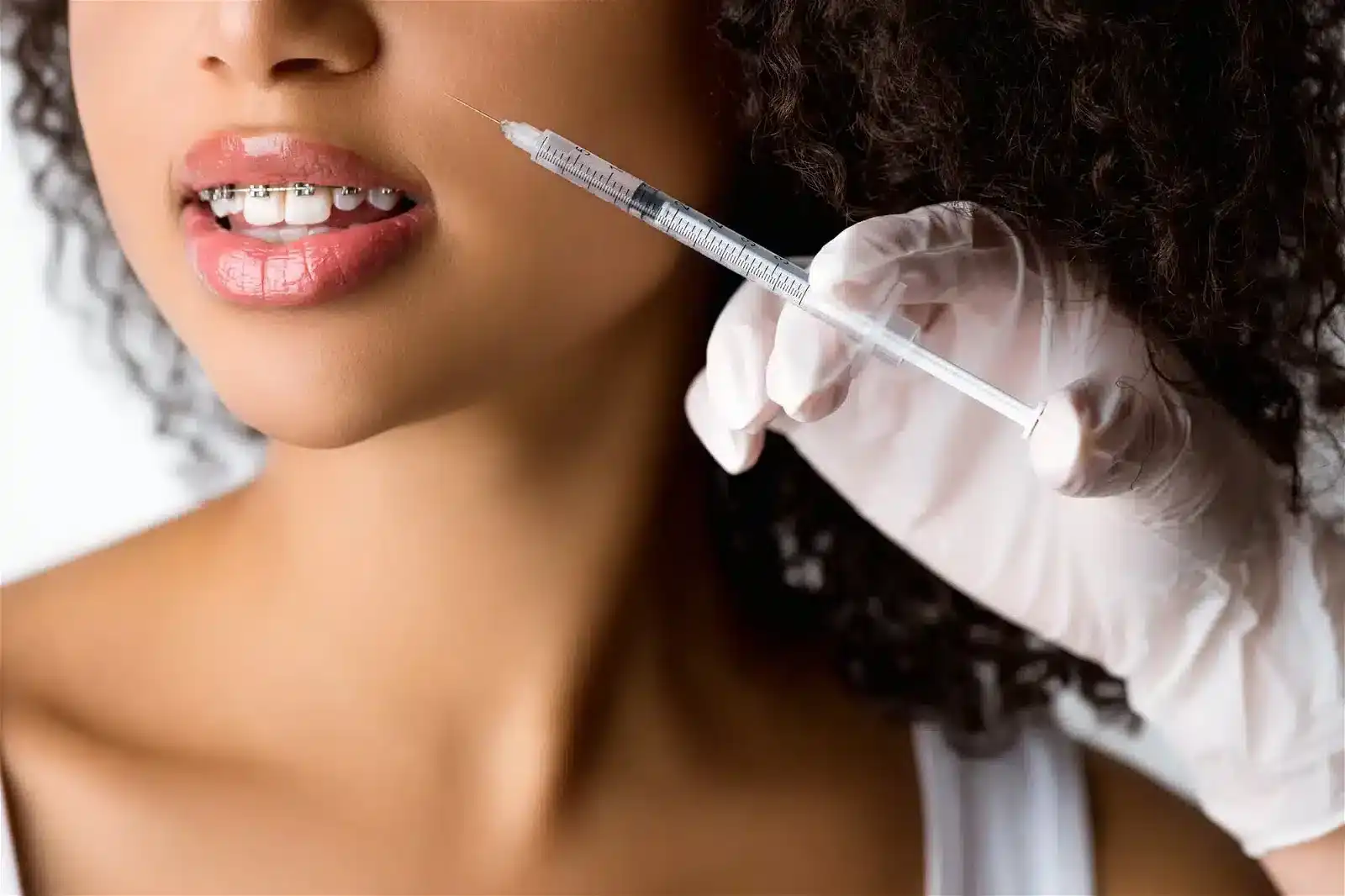
Application of Dermal Fillers in Dental Settings
David Fuller
Last Updated On: October 15, 2024
Dentistry has long been a cornerstone of enhancing dental aesthetics – color, shape, and alignment, but these days, it also covers pink aesthetics (gums and soft tissues surrounding the teeth). This includes addressing issues such as receding gums, uneven gum lines, and gum volume loss that play a crucial role in achieving a harmonious smile.
Dentists use dermal fillers to restore the lack of tissue in cases of gum recession, open gingival embrasure, and soft tissue volume loss, rejuvenating the smile and creating a more pleasant and refreshed look.
White and Pink Aesthetics in Dentistry
White aesthetics has long been the domain of traditional cosmetic dentistry, involving operations with the color, shape, and alignment of teeth to create a pleasant-looking smile.
However, despite the transformative potential of these treatments, they often address only one aspect of dental aesthetics. Neglecting the appearance of the gums and gingival embrasures negatively affects the overall appearance of the smile.
Periodontal care, though less frequently discussed, is just as crucial in achieving a balanced and pleasing smile. The gums, mucosa, and gingival tissues frame the teeth, providing a backdrop against which the teeth are showcased.
Optimal pink aesthetics entail having healthy, well-contoured gingival tissues that seamlessly merge with the teeth, creating an aesthetically pleasing transition from tooth to gum, and this is where dermal fillers are used for dental work.
Gingival embrasures, those V-shaped gaps between teeth, serve both functional and aesthetic purposes, allowing for proper teeth cleaning, assisting in speech articulation, and contributing to the overall appearance of a smile. Yet, discrepancies in gingival embrasure size can lead to issues that mar the facial aesthetics completely. Achieving the gingival embrasure closure is a cornerstone of smile design and is where dermal fillers have emerged as an innovative tool in the dentist’s arsenal.
Integration of Dermal Fillers in the Dental Setting
Nowadays, dental work and fillers go hand-in-hand. Dentists use dermal fillers for various purposes, primarily related to enhancing dental-facial aesthetics:
- Addressing issues like uneven gum lines and gum volume loss to create a gingival embrasure closure and improve pink aesthetics. Dentists can create a more harmonious gum line and enhance the smile’s overall appearance by injecting fillers into the spaces between teeth.
- As individuals age, the appearance of their smiles can change due to gum recession and soft tissue volume loss. Dentists use dermal fillers to rejuvenate the smile by restoring lost volume, creating a more youthful and refreshed look.
- In some cases, dermal fillers are used to provide support and relief to patients experiencing pain associated with TMJ disorders. The filler is injected into specific areas to alleviate discomfort and improve joint function.
- After oral surgeries, such as wisdom teeth extraction or orthognathic surgery, dermal fillers may be used to improve the healing process, reduce the appearance of scars, and help maintain facial symmetry during the recovery phase.
The specialized training and expertise are crucial to use dermal fillers in the dental setting. Dentists must have a deep understanding of facial anatomy, aesthetic principles, and injection techniques for treatments with dermal fillers to ensure safe and effective outcomes.
Patient Selection and Treatment Procedure
The application of dermal fillers in aesthetic dentistry highly depends on patient selection and consultation. Dentists must exercise careful judgment when identifying suitable candidates for these treatments. A thorough consultation is necessary for managing patient expectations and ensuring the best possible outcomes.
Ideal candidates for treatments with dermal fillers in dental work generally include individuals with gingival embrasure discrepancies, uneven gum lines, or those seeking to enhance the overall aesthetics of their smiles. Patients should be in good oral health, without active periodontal diseases, and come into the procedure with realistic expectations.
During the consultation, the doctor conducts a comprehensive assessment of the patient’s oral health and facial structure, including evaluating the condition of the gums, teeth, and surrounding tissues. X-rays and photographs may be taken to aid in treatment planning.
Dentists must engage in open and honest discussions with patients regarding their aesthetic goals to understand what they hope to achieve. They must also clearly explain what is achievable with dermal fillers.
Based on the assessment and the patient’s goals, the doctor devises a customized treatment plan, outlining the specific areas to be treated, the type and amount of dermal filler to be used, and the expected outcomes. At this stage, dentists must select a filler that is safe for use in the oral and perioral region and provides the desired longevity of results.
The actual procedure involves the injection of dermal filler into the specific areas of the gums and gingival tissues that require enhancement. The injection technique and depth vary based on the patient’s unique needs and the desired outcomes.
Doctors should explain to each of their patients that, while dermal fillers are proven to provide remarkable progress in gingival embrasure closure and aesthetics, the results are not truly permanent. They typically last from several months to over a year, depending on the specific filler that was used. Periodic touch-up treatments are often necessary with some products, to maintain the desired appearance.
Potential Risks and Complications
As with any medical or dental procedure, using dermal fillers in a dental setting comes with potential risks and complications that require careful consideration:
- Infection;
- Allergic reactions;
- Temporary bruising and swelling at the injection area;
- Asymmetry;
- Filler migration.
In rare cases, dermal filler treatments can lead to tissue necrosis if the filler obstructs blood vessels. Early recognition and appropriate situation management are crucial in mitigating this risk.
Aftercare
Patients may experience some degree of bruising, swelling, and discomfort immediately following the procedure with dermal filler. Dentists must provide post-care instructions on managing these side effects, including using cold compresses and avoiding certain activities.
Patients should continue their regular oral hygiene routine but may need to take extra care around the treated areas using a soft toothbrush and gentle brushing techniques to avoid disturbing the fillers.
The follow-up appointments are essential to monitor the results, address any concerns, and plan for touch-up treatments if necessary.
As the results achieved with dermal fillers are not permanent, maintenance treatments may be required to sustain the desired appearance.
Conclusion
The use of dermal fillers in dentistry is not a mere trend but a transformative approach that underscores the dynamic nature of dental practice in modern times.
Dentists, traditionally associated with white aesthetics in the cosmetic dentistry, are now extending their expertise to provide their patients with better overall results. Dermal fillers in dental work facilitate creating harmony between the teeth and the gums, offering new possibilities for enhancing oral aesthetics.
FAQ
What dermal fillers do dentists use?
Typically, dentists use dermal fillers specifically formulated and approved for the oral and perioral regions. The choice of dermal filler product depends on the specific application and the desired outcomes. Here are the types of dermal fillers used by dentists:
Hyaluronic Acid fillers (for example, Restylane and Juvéderm) are popular in dentistry due to their compatibility with the body and versatility. They add volume to soft tissues and can be employed for improving pink aesthetics and smile rejuvenation.
Calcium Hydroxylapatite (CaHA) fillers (Radiesse) provide longer-lasting results and stimulate collagen production in the treated areas. They can address volume loss in the perioral region and contribute to smile rejuvenation.
Polymethyl Methacrylate (PMMA) fillers (Bellafill) offer a more permanent solution for smile enhancements and are used to add volume to the lips and perioral areas.
Poly-L-Lactic Acid (PLLA) fillers (Sculptra) stimulate collagen production over time, address volume loss in the perioral region, and contribute to smile rejuvenation.
The choice of filler for dental work depends on various factors, including the patient’s specific needs, the expected duration of results, and the doctor’s experience and preferences. Dentists must thoroughly understand the properties and characteristics of each filler type and brand to ensure safe and effective treatments. Additionally, they should consider patient allergies and sensitivities when selecting the appropriate filler product.
Can dentists use dermal fillers on the face?
Yes, dentists can legally inject dermal fillers in certain areas of the face, particularly in the perioral region. They are trained in the anatomy of the face and the oral cavity and well-equipped to administer dermal fillers for specific facial enhancements such as smile rejuvenation and addressing nasolabial folds and marionette lines.
However, providing facial dermal injections should align with the dentist’s scope of practice and specific training and qualifications. Dentists who wish to provide dermal filler treatments on the face must undergo specialized training and certification in cosmetic and aesthetic procedures, including dermal filler administration.
References
Tran Cao P. The Use of Botulinum Toxin and Dermal Fillers to Enhance Patients’ Perceived Attractiveness: Implications for the Future of Aesthetic Dentistry. Dent Clin North Am. 2020;64(4):659-668. doi:10.1016/j.cden.2020.06.003.
Al Hamdan EM, Algheryafi AM, Al-Ghareeb FJ, Ashri NY. Knowledge and attitude of dentists towards the use of botulinum toxin and dermal fillers in dentistry, Riyadh, Saudi Arabia. J Cosmet Laser Ther. 2013;15(1):46-54. doi:10.3109/14764172.2012.758377.
Sonone TP, Soni V, Gupta SD, Shekatkar Y, Thorat AS, Pol T. Botox and dermal fillers in orthodontics – A review. Journal of Pharmacy and Bioallied Sciences. 2022;14(5):60. doi:10.4103/jpbs.jpbs_184_22.
Naorungroj S. Esthetic Reconstruction of Diastema with Adhesive Tooth-Colored Restorations and Hyaluronic Acid Fillers. Case Rep Dent. 2017;2017:5670582. doi:10.1155/2017/5670582.
Sheen D, Clarkson E. Botox, and Dermal Fillers: Review and Its Role in the Dental Office. Dent Clin North Am. 2020;64(2):325-339. doi:10.1016/j.cden.2019.12.002.
Products
Cart
Log In
Newsletter
Subscribe for exclusive offers and updates on new arrivals
Share feedback at:
Working Hours
MON - SUN 9AM to 6PM EST
The Most Popular Brands
Med Supply Solutions
Support
Secure checkout is guaranteed with full adherence to PCI DSS payment standards.
Products listed here are guaranteed authentic and manufacturer-sourced.
Pay easily with trusted providers


Copyright 2025. Med Supply Solutions